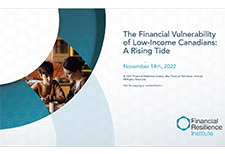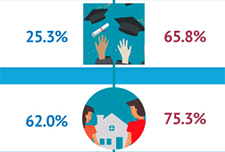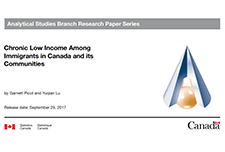Discover financial empowerment resources
Discover financial empowerment resources
The ballooning cost of living has had a disproportionate impact on low-income households, 77.6% of whom are financially vulnerable or extremely financially vulnerable. Prosper Canada's recently commissioned study from the Financial Resilience Institute, shows the unarguable deteriorating state of...

This report is about the financial resilience and financial well-being of Canadians with low incomes based on the Seymour Financial Resilience Index ® It provides a call to action for more targeted support from policymakers, financial institutions and community non profit organizations for...

The infographic "Intergenerational income mobility: The lasting effects of growing up in a lower-income family" based on the article "Exploration of the role of education in intergenerational income mobility in Canada: Evidence from the Longitudinal and International Study of Adults," published in...

This study examines the affect that an increase in household income, due to a government transfer unrelated to household characteristics, has on children's long-term outcomes. It is found that increased income increases children's educational...
This research paper investigates the association between the patterns of duration, timing and sequencing of exposure to low family income during childhood, and symptoms of mental health problems in...

Income volatility is increasing in the United States and presents a growing public health problem. This study examines associations of long-term income volatility with incident cardiovascular disease and all-cause...

This study examines the rate of chronic low income among adult immigrants (aged 25 or older) in Canada during the 2000s. Data is taken from the Longitudinal Immigration Database (IMDB) for the period from 1993 to 2012, with regional adjustments used for the analysis. Chronic low income is...

Living in a community with lower socioeconomic status is associated with higher mortality. However, few studies have examined associations between community socioeconomic characteristics and mortality among the First Nations population. The Community Well-Being Index (CWB), a measure of the social...
...
This article explores how skill proficiencies are related to household income for Canadians aged 16 to 65 using data from the first wave of the Longitudinal and International Study of Adults (LISA), conducted in 2012. The article also demonstrates how the relationship between skill level and low...
Current income is usually insufficient to cover college costs in most families, who believe that they must save for college for their children. Furthermore, effects of household savings and asset holding may extend beyond financial security and affect long-term development of children through...
This report was commissioned by the SMCPC for the purpose of replicating for the British case, as far as possible, the findings in Our Kids. In this era in which public concern about poverty, inequality, and social mobility has been increasing, our primary aim in this report is to find out if the...
Spanning over four decades, the Panel Study of Income Dynamics (PSID) is the world’s longest-running household panel survey. The resulting data archive presents research opportunities for breakthroughs in understanding the connections between economic status, health and well-being across...
Most Americans are aware that income inequality has increased in the last 30 years. Less well known is that income instability—how much families’ incomes fluctuate up and down over time—has also grown substantially. The Great Risk Shift (Hacker 2006; revised and expanded in 2008) documented a...
